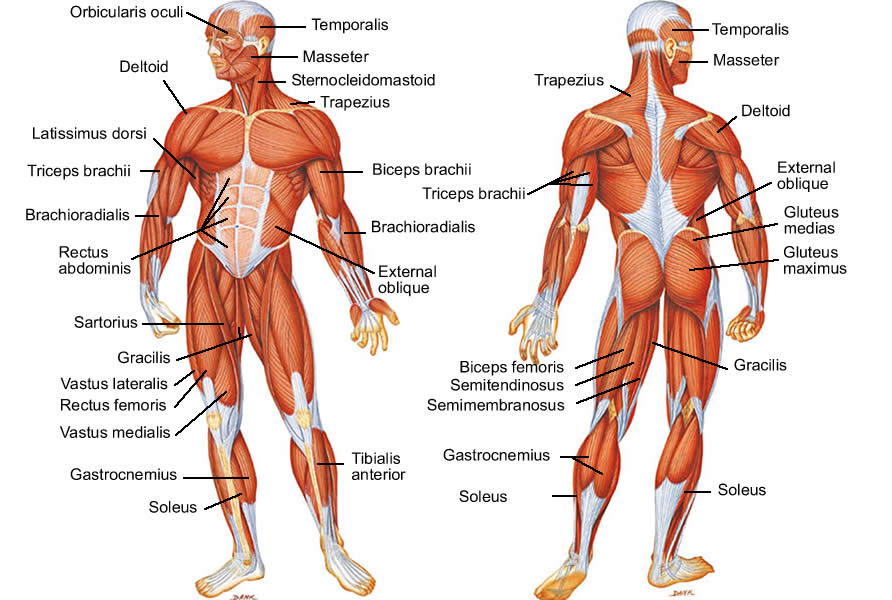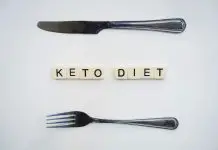What do you picture when you heard the word “muscles”? Body builders? Weight lifting? Popeye? Muscle maintenance and function is much more basic than rippling biceps and rock hard abs.
Especially as you age, understanding muscle physiology and practicing both positive fitness and dietary habits can make a huge difference when it comes to your muscle health.

Main muscles in the body; image source: pinimg.com
There are over 600 muscles in your body, powering your movements, pumping blood throughout your body, and protecting your vital organs. Even small, manageable lifestyle habits and diet modifications can make a huge difference in promoting muscle health as you age – check out these top 6 tips:
Pump up Your Potassium
As an electrolyte, potassium (along with magnesium) transmits vital electrical signals in the body to in part regulate muscle contraction. A 2015 study found that over 80% of Americans don’t get the daily recommended amount of potassium.
Nutrient-rich foods like avocados, kidney beans, bananas, winter squash, and dried figs provide delicious, natural dietary options for pumping up your potassium intake without having to take a prescribed supplement.
Stretch, Stretch, Stretch
Honing your flexibility as you age means keeping muscles and joints limber and elastic through stretching. Did you know the best time to stretch muscles is when they are warm and pliable, so typically after a workout, not before?
More dynamic movements like jumping jacks or brisk walking makes for a good warm up, while stretching post-workout or after playing a sport helps lengthen muscles and loosen joints. Experts recommend holding a stretch for at least 25 or 30 seconds at a time instead of doing quick bursts or bounces – a held stretch overruns the muscles natural inclination to contract and helps it relax and lengthen.
Avoid Awkward Movements
You just know you can reach that tiny brooch you dropped behind the dresser if you simply bend that weird way, twist your arm, and reach as far as you can, right? We’ve all been there. Awkward, straining movements like these can quickly result in muscle spasms, inflammation, and even pinched nerves.
For older adults, seemingly harmless actions like these can also result in dangerous falls and injury. What do you do instead? Use the best reacher grabber tool you can find to grab hard to reach items on the floor or up on shelves – or ask a taller spouse or friend to help.
Pack in the Protein
Retain (and gain) muscle mass with the amino acids, iron, choline, zinc, and B-vitamins that edible proteins afford you. Amino acids are the building blocks of muscles and are necessary to growing and repairing them. Healthy proteins with essential amino acids don’t just include lean beef, fish, and skinless chicken.

Dairy products like cottage cheese and greek yogurt, plus eggs and even high protein whole grains like brown rice and quinoa provide meat-free protein-rich meal alternatives.
Boost Balance and Coordination
Muscle groups which function together cohesively to provide a full range of motion power your flexibility. As you age, staying flexible goes hand in hand with retaining a sense of balance and coordination. Mindfulness activities like yoga and tai chi provide flexibility training, deep breathing techniques, and balance practice, all which benefit your muscle groups and even your heart health. Tight muscles and stiff joints not only cause pain, but can slow movements and make it harder to stay active and remain mobile.
Strong, healthy muscles which boost balance and coordination can help prevent falls when you’re older and even benefit your mental health – helping you exercise regularly and practice fine motor skills to combat cognitive decline.
Practice Good Posture
The sedentary habit of spending most of the day sitting (working, eating, and on the computer, for example) can leave a lasting impact on your muscles, so practicing good posture is a priority for promoting future muscle health.
Continuous bad posture launches a domino effect starting with the spine which can cascade through the rest of your body – neck, hips, legs, knees, feet – resulting in chronic structural changes that cause muscle inflammation, strain, and even injury.
Comprised muscles can negatively limit how your body burns fat, your flexibility, how you build strength, and even cause acute and chronic pain. Avoid slouching and slumping, and never sit more than 45 minutes at a time without getting up to stretch and move around.
To the average human, it’s surprising as to how many bodily functions and processes actually involve your muscles – from weight management and insulin regulation to metabolism, heart and bone health. As you age, natural degradation of muscle tone and strength may seem like the inevitable.
That simply doesn’t have to be the case. With continued exercise and flexibility practice, good posture, and a healthy diet, you can protect and strengthen muscles well into your Golden Years.








































